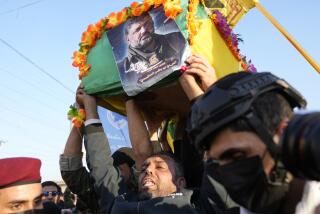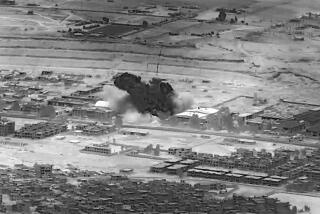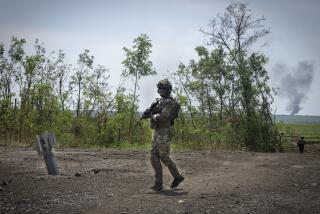U.S. Tries New Kind of Urban Combat
- Share via
WASHINGTON — The decision by U.S. commanders to seize control of key sites in the heart of Baghdad -- after three nights of brief armed forays into the city -- underscores the military’s growing confidence that organized Iraqi resistance is weakening.
Unlike the tank convoys rolling through central Baghdad since Friday, the new encampments at places such as government buildings could provide clear targets for Iraqi troops. But American commanders now doubt the city’s defenders are capable of mounting large-scale organized attacks.
“I think the command and control of the Republican Guards is at the point now where the most they can do are sporadic attacks from very, very, very small units,” Air Force Gen. Richard B. Myers, chairman of the Joint Chiefs of Staff, said Monday at a Pentagon briefing.
The tactic U.S. ground forces in Baghdad are using is strikingly different from anything attempted previously in urban combat, and is considered highly experimental by war planners.
It involves first launching a series of armed reconnaissance missions into a city, as Army and Marine units have done since Friday in what planners dubbed “Thunder Runs,” and then, with a clearer picture of the enemy’s capabilities, establishing beachheads at strategically critical sites inside the city.
“They’ve obviously found some places they think they want to stay at for a while to make a point and maybe to control them,” said retired Marine Col. Gary Anderson, an expert in urban warfare and former chief of staff at the Marine Corps Warfighting Lab at Quantico, Va. “I think you’re going to see more of that. And one day, I think the city’s going to wake up and see that they’re there to stay.”
By occupying one of Saddam Hussein’s palaces and camping outside the headquarters of his infamous Ministry of Information, U.S. forces hope to break the psychological control the Iraqi leader has on the capital.
But even as U.S. troops bedded down in central Baghdad on Monday, the tanks and armored vehicles around them and the guns they pointed outward were testament to the enormous challenges U.S. forces still face in trying to take control of a capital city of 5 million people.
U.S. commanders acknowledge that although the Republican Guard appears to be in disarray, there still are thousands of members of Hussein’s Special Republican Guard inside the capital and “their fighting spirit might be a little bit higher” than the battered army.
And even if U.S. troops manage in the coming days to rapidly destroy what organized fighting forces the Iraqi regime has left, they face the real prospect of fending off protracted guerrilla-style attacks long into the future.
“What we are not seeing is an overarching structure of control,” Army Brig. Gen. Vincent Brooks, deputy operations director for the U.S. Central Command in Doha, Qatar, said Monday. “We believe that’s been significantly degraded, but that doesn’t mean that there is an elimination completely of all threats.”
Traditionally, fighters waging war in cities have attempted to seize territory at the outskirts of the urban area, then push inward, taking territory block by block, instead of launching the assault by first seizing strategically important areas.
The advance by U.S. forces, in contrast, is designed as much to prove a point as to take territory. Troops in coming days probably will stay overnight at some locations, then move on to others. Eventually, they may establish secure zones throughout the city, to isolate Hussein loyalists in a smaller and smaller area.
While ground troops continue to storm through Baghdad streets, U.S. and British warplanes have established round-the-clock combat air patrols over the city, flying A-10 gunships in broad daylight and landing combat and cargo planes at Baghdad International Airport. It’s a show of air supremacy that military officials say is designed to make the point to Baghdad residents that control of the city is slipping from the Iraqi regime.
Still, U.S. troops are unlikely to move immediately and in force into Baghdad, instead continuing to take control of key buildings such as palaces and ministries, then broader areas. If all goes according to plan, military officials said, they will retain the ability to quickly move out or pull in reinforcements as needed.
“We can’t have an Alamo,” one military official said. “We need flexibility.”
Brooks told reporters Monday that field commanders are in a position to maneuver virtually at will inside Baghdad. They can “exert greater authority in different places, or simply go directly to where they happen to have intelligence on where any regime forces might be located,” he said.
The increasing confidence of American commanders is tempered by several unknowns. It is unclear how many guerrilla fighters may be hiding in Baghdad. The incursions have been on the west side of the Tigris River, a relatively open space with many government buildings, ministries and palaces, but few of the densely populated neighborhoods that will make fighting in other parts of Baghdad so difficult. Many suspect the situation will be different if, and when, they cross the river.
“This is not a TV show, so let’s not go too quickly,” said Judith Yaphe, a senior research fellow with an expertise in Iraq at National Defense University in Washington. “What happened to the Republican Guards? Did they melt away? Where have they hidden? Something is still clearly going on there. Each day people are too quick to say it’s over.... It doesn’t seem to me there will be any big decisive battle. It is more likely you will get sucked in street by street.”
In fierce fighting Monday in parts of Baghdad, U.S. forces fired artillery at Iraqi fighters using machine guns and grenade launchers, in a traditional, if lopsided, battle. But there were signs of less conventional guerrilla warfare as well. Six cars charged the tanks of the 3rd Infantry Division’s 2nd Brigade and stopped only when U.S. shooters destroyed them. At least one was loaded with explosives, commanders said, in what appeared to be another attempted suicide car-bombing.
Brooks said it was impossible to estimate the number of Iraqi soldiers who are joining militias.
“What we can do is recognize, as we have throughout this operation, that there are certain capabilities that will always exist out there that can threaten the force and also threaten the peace, and we’ll deal with those in a logical and appropriate way,” he said.
“I think you’re going to see an attempt, even if it’s not well organized, on the part of the die-hards to resist for a long time,” said retired Lt. Gen. James Terry Scott, former chief of the Army Special Operations Command. “But they have fought so poorly to this point I think it would be a real surprise to see them be able to execute much of a significant threat.”
*
Times staff writer Michael Slackman and researcher Hossam el-Hamalawi in Cairo and Tracy Wilkinson in Doha, Qatar, contributed to this report.
More to Read
Sign up for Essential California
The most important California stories and recommendations in your inbox every morning.
You may occasionally receive promotional content from the Los Angeles Times.













